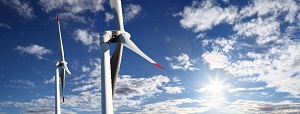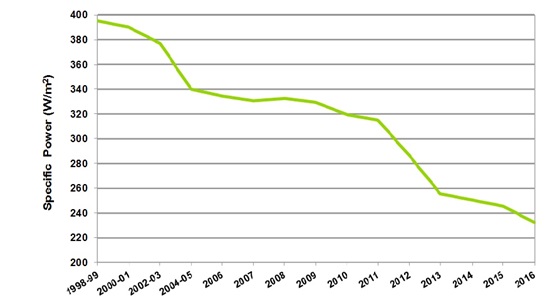- Energy Technologies
- Energy Technologies
- Wind Turbines
- Wind Power
Making More with Less: Maximizing Generation in Lower Wind Resources Regions

Wind turbine manufacturers are constantly evolving their turbines to maximize power output in areas of lower wind speeds, which opens much more geography for wind projects. A simple metric for quantifying wind resource areas for turbines is specific rating (or specific power). Specific power is the ratio of a turbine’s rated power output in watts to its swept area in square meters. A turbine with a higher specific power is designed for areas with high wind resources and vice versa. Higher specific power indicates that a turbine can generate more power with less swept area (i.e., a smaller rotor diameter). These turbines need high winds to adequately perform. Otherwise, capacity factors and associated power output are too low to make the turbine cost-effective. If the average winds are not sufficient for high specific power turbines, a turbine with a lower specific rating will be used. For developers and owners looking to find the right turbine for their location, it’s all about finding the right balance based on wind resources. For example, a 2 MW turbine with a 90-meter rotor might produce 6 GWh with an average annual wind speed of 7 m/s. A 120-meter rotor turbine with the same rating would produce 8.5 GWh in the same conditions. The 120-meter rotor turbine will be more expensive to manufacture, transport, and install, so the higher power output comes at a price—but the tradeoff can be worth it.
Changing of the Times
There are four different classes of wind turbines based on average annual wind speed, among other parameters: I, II, III, and IV. Two decades ago when wind energy costs were high, typically only wind farms in high wind resources regions with Class I turbines made economic sense. As wind costs continue dropping, wind turbine OEMs are prioritizing Class II and Class III turbines. According to the US Department of Energy’s 2016 Wind Technologies Market Report, the average wind class for turbines in the United States shifted from 1.2 in 2000 to 2.7 in 2016. As noted in the figure below, the average specific power of installed turbines in the United States has plummeted in the last 20 years, dropping from almost 400 W/m to 230 W/m. Typically, a Class I turbine has a specific power of 400 W/m or higher. Class II turbines will be between 300 W/m and 400 W/m and Class III between 200 W/m and 300 W/m. Class III turbines are the popular choice around the globe and have been for several years now.
Average Specific Power, United States: 1998-2016

(Source: Office of Energy Efficiency and Renewable Energy)
Guidehouse Insights’ Wind Turbine Order Tracker follows the average specific power for turbines to be used in upcoming projects. Major turbine OEMs like Vestas and Siemens (now Siemens Gamesa Renewable Energy, or SGRE) have seen dropping specific powers. The average specific power for Vestas turbines dropped from 297.3 W/m in 1H 2016 to 250.9 W/m in 1H 2017. In the latest version of the Tracker to be published next month, Vestas, SGRE, Nordex, Senvion, and GE have specific ratings between 240 W/mand 270 W/m. Class III turbines account for over 90% of the turbine capacity awarded between January and June 2017, and less than 2% went to Class I turbines. Clearly, the times have changed in the wind industry and low wind resources are no longer a deal breaker for potential wind sites. As costs continue to drop and technology improves, project developers and owners will continue to gain what they didn’t have much of 20 years ago: options.